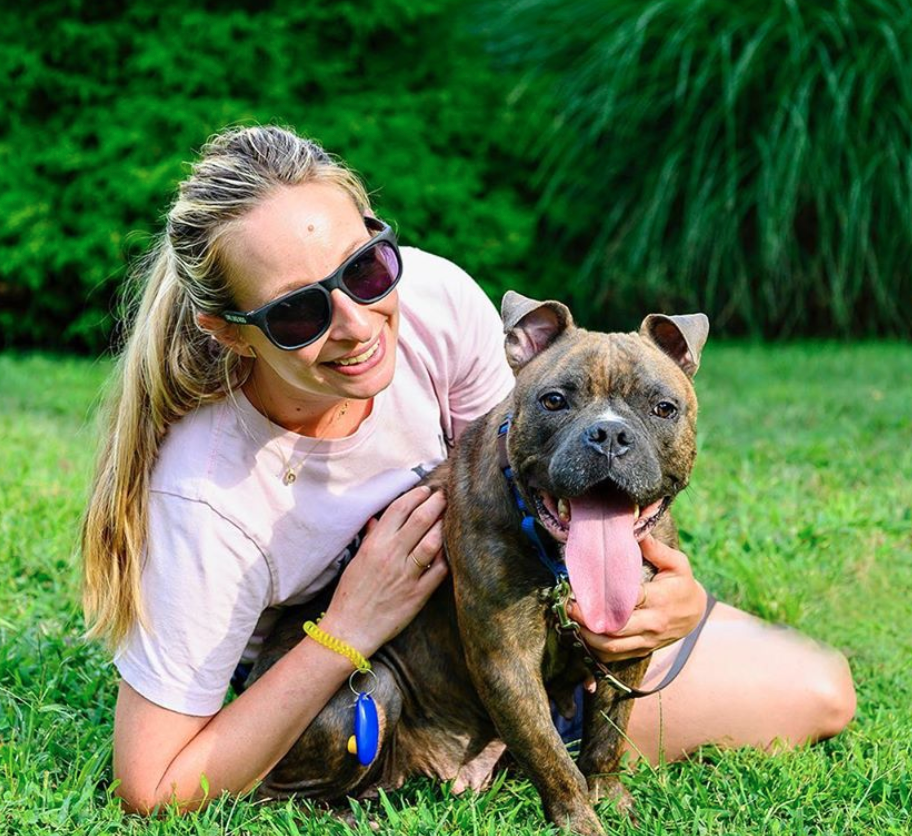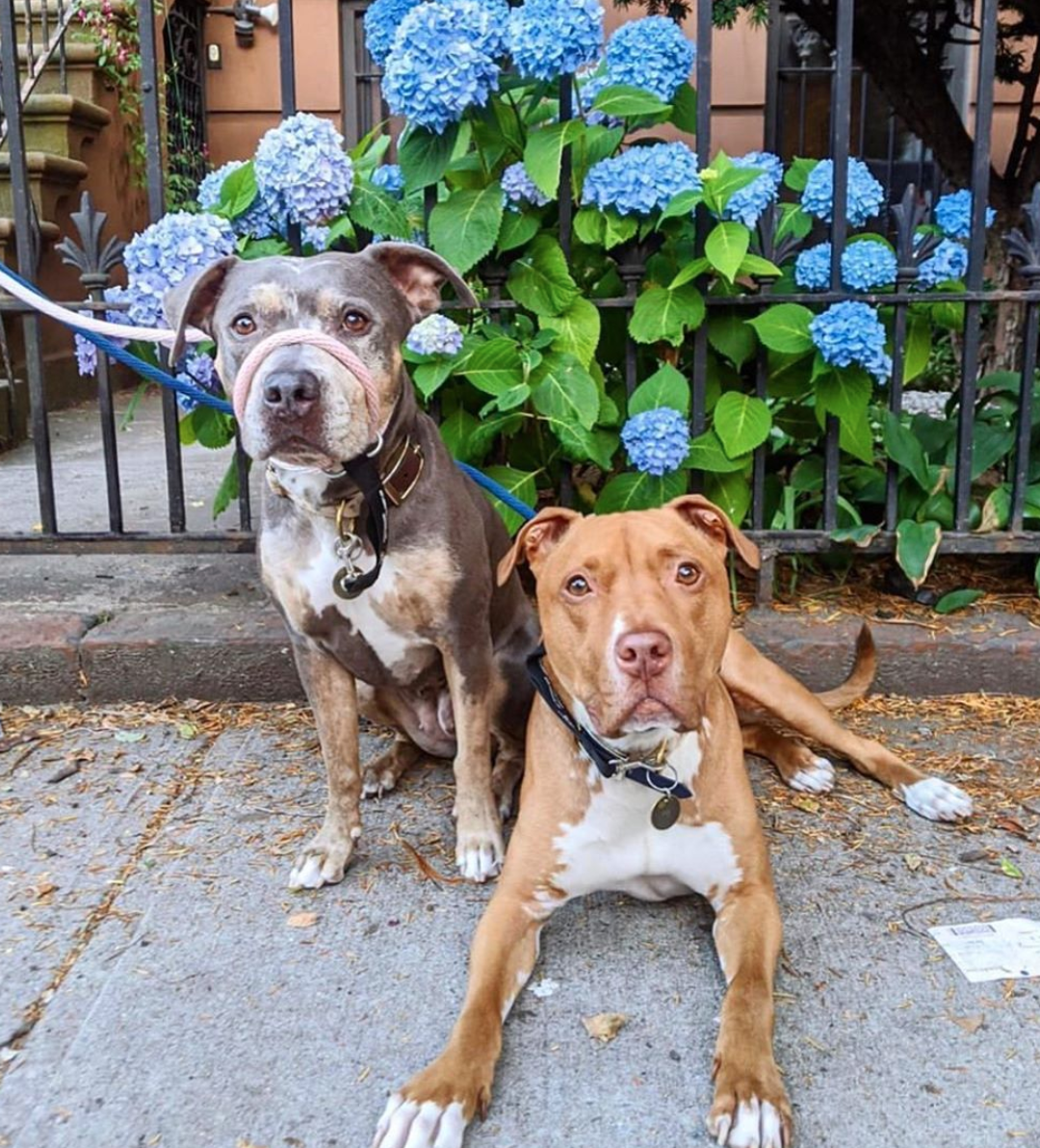Pitbull Awareness Month: Meet Anya
In honor of Pit Bull Awareness Month, Muddy Paws sat down with Pit Stop NY and Well Mannered Mutt founder Anya Kopchinsky to discuss her work with pit bulls, dispel common myths, and advocate for America’s most misunderstood breed.
How did you first get involved with pit bulls?
In 2007, I visited Stamford Animal Control to get a cat—I wasn’t ready for a dog—and ended up meeting Ali Girardi who runs a wonderful fundraising group called Outreach to Pets in Need. The group was very involved in the shelter and after volunteering just once with them, I became obsessed with the dogs and the work they were doing. I quickly became the Volunteer Manager and later took on a training role. I then fostered my first “pit bull”-type dog and realized that advocacy was a natural side effect of owning and fostering a dog considered by the public to be a pit bull. I experienced the typical stigmas associated with owning a pit bull-type dog right away (and experienced them daily) as the municipal shelter was absolutely full of pit bull-type dogs—and no one wanted them. In my time with the Stamford shelter, and later as a Kennel Technician and Adoption Counselor at the Connecticut Humane Society, I have probably escorted hundreds, if not thousands, of people down kennels and heard the words “anything but a pit bull” at least 50% of those times.
How did those experiences launch you further into pit bull advocacy?
After a few years at both the municipal shelter and at a private shelter, I recognized a hole that needed to be filled by a reputable foster-based rescue in the area. After having some negative experiences with the one pit bull rescue nearby, I teamed up with Cat Assistance NY to start an offshoot called Pit Stop NY: an all volunteer-based rescue specializing in pit bull-type dogs. Through Pit Stop, I have had over 300 pit bull-type dogs in my home as foster dogs. My volunteer work with Pit Stop continues and will for a long time. In addition, for the past three years, I have been an active responder for the ASPCA Field Investigations and Response Team consulting on federal dog fighting, hoarding, puppy mills, neglect cases, and natural disasters all over the US and St. Croix.
Anya with her ASPCA team. (Pitstop-training.com/Anna Kopchinsky)
What have you learned from your work in this field?
Through my work with the ASPCA, I found my real passion of rehabilitating dog-fighting survivors. The work has also taught me a lot about behavior, enrichment, and especially aggression: after going to behavior and aggression seminars for 10 years and through many invaluable mentorships, I realized that the next natural step to advocacy and helping pit bull-type dogs was to become a certified professional dog trainer. I now have my own dog training business in Fairfield, CT (and all over the world thanks to Zoom) called Well Mannered Mutt. I became Fear Free certified in 2019 and started to contract for a wonderful behavior research center called Dogs Playing For Life. I now specialize in pit bull-type dogs and through this work have formed a real love and understanding for them.
Source: @pitstopny, Instagram
There are many myths circulating about pit bulls that prohibit their adoption. What are some myths you’ve frequently encountered?
One of the major myths I’ve heard is that it’s “all in how they are raised.” Though well-intentioned, this a) isn't true and b) isn't helping anyone. I’ve seen and fostered dogs raised in the most horrific environments and even they have blossomed into beautiful pets. I have taken federal case dogs off their 50 pound chains and brought these same dogs into my home. Each and every one of the dog-fighting survivors I have taken as foster dogs is now flourishing in a home and most of them even live with other dogs too. On the other hand, you can have a dog raised perfectly with just the wrong touch of genetics that becomes a difficult pet, pit bull or not.
Specifically with fighting dogs, I have heard a lot of people say these dogs are dangerous to people. Quite honestly, it’s ridiculous to think that because they fought, they automatically are going to become aggressive toward people. Many also claim that pit bulls have locking jaws. This is just anatomically not possible. They do not have locking jaws. If you compare the skull of a pit bull to any other dog, you can see with the naked eye that both skulls have the same characteristics and anatomy. According to Dr. Lehr Brisbin of the University of Georgia, no dog—of any breed or mix—has an anatomical structure in their jaw that functions as a locking mechanism. Dr. Brisbin states,
“We found that the American pit bull terriers did not have any unique mechanism that would allow these dogs to lock their jaws. There were no mechanical or morphological differences...”
If you have a “good” pit bull, they have determination—this is different. This is not a locking jaw. Just because your dog won’t let go of something, does not mean it has a locking jaw; usually dogs let go because the challenge/conflict makes them back off, or because they are scared. If you have a dog who likes conflict and doesn’t have fear, they aren’t going to let go. Think about people that get jacked at the gym: they don’t have different DNA than yours, they are just more determined and driven.
Can you briefly discuss the history of pit bulls and how they were given their unfair reputation?
Pit bulls are often falsely referred to as ‘nanny dogs.’ Let me flat out say that no dog should be considered a nanny dog—pit bull or not. No dog is meant to be your babysitter. I can’t be an advocate for dogs and let that myth continue!
The traits that made a “good” historical fighting dog are ones that include a high tolerance for pain and sociability. Generally, dogs bite out of fear and out of pain. Because pit bulls are a breed with a higher pain tolerance, this reduces the likelihood of bites out of pain. A brave and courageous dog that isn’t afraid of every little thing isn’t likely to bite out of fear, so pit bulls can be more stable than the average dog in a family environment. The same characteristics that make a good pit dog does usually make them good with kids and make them really good family dogs.
Unfortunately in old-school dog fighting, the dogs were matched and given a bath by the competitor to prove that the dog did not have anything on its coat to give it an upper hand in a fight. This means that a stranger had to give the dog a bath in an incredibly stressful environment—you can’t do this to the majority of dogs today regardless of breed. Additionally, a neutral third person is traditionally supposed to be the one breaking up the dog fight to prevent the dog from developing zero aggression toward humans. These dogs are incredibly brave and courageous and driven to “work” under distracting conditions. The breed has a history of human tolerance under extreme duress that you do not find in any other dog—no dog has had this selective pressure like a pit bull.
Let’s get into training—what are some of your practices?
I will tell you, there was a time when I thought two pit bulls simply couldn’t live in the same house. I used to have major problems with dogs “attacking each other out of nowhere.” The training methods I started with were incredibly aversive and simply not helpful. I just trained every dog I had not to give any warning when they were uncomfortable. I would use a prong collar to stop the dog from lunging and barking and would correct every growl and method of communication the dog chose to use.
Since then, I have learned a lot. I have completely changed my approach and decided to adapt the philosophy presented by the IAABC and CPDT called LIMA (least intrusive, minimally aversive). I advocate for my dogs now. If I see that they need space, I make it for them. I use a loooot of treats to positively reinforce the behaviors I like and want to continue! I take my time and as much time as the dog needs. I am also really into biological fulfillment and enrichment for working dogs like pit bulls. They need things to do and they are incredibly smart and willing to work with you.
Source: @pitstopny, Instagram
What do you think are the most important elements of training?
I think many dogs have been taught (probably inadvertently) that they are supposed to take on threats themselves. My biggest thing in training is making sure the dog knows that I will take on the threat; it’s simply not on the table for them. They have no reason to believe that I won’t keep them safe. When I bring new dogs into my house, I am always showing the dogs that I have things under control. This is where the leadership comes in—not the dominance techniques you’ve likely heard. Leadership is all about advocating for your dog. In my house, new dogs are tethered to me and the resident dogs will sometimes have drag leashes on to keep everything safe so I can maintain control if necessary. I use muzzles all the time—probably too much—but safety and protection of the dogs in my care is my main priority.
Ultimately, training is all about trust and clear communication. You want to provide direction, guidance, and protection. You course-correct when necessary and you decision-make for the greater good of your team. You have consequences for bad behavior, but you also recognize and praise good behavior.
Source: @pitstopny, Instagram
Is training a pit bull really so different than other breeds?
Pit bull-type dogs are no different than other dogs. They learn by the same learning theory used in humans. Always think of the ABC’s—Antecedents, Behavior, and Consequence. Is the behavior being reinforced or punished? You can tell this by whether the behavior is continuing or whether it is becoming less frequent. If the behavior is becoming more frequent, it’s being reinforced somehow. Take for example, barking at the mailman: the antecedent is the mailman showing up, the dog then barks, the mailman leaves. It works for the dog every time. Threat comes, dog barks, threat leaves.
What are some resources you can recommend for people who want to learn more about pit bulls and who want to get involved in their advocacy?
My website, Well Mannered Mutt
To learn more about finding the right trainer, look here, at CCPDT, or IAABC
Great books include Canine Enrichment for the Real World by Allie Bender and Emily Strong, Don’t Shoot the Dog by Karen Pryor, Meet Your Dog by Kim Brophey, and The Culture Clash by Jean Donaldson
Muddy Paws Foster Program Coordinator Brittany Lee also recommends Lost Dogs by Jim Gorant—a book about the rehabilitation of the dogs that were seized from Michael Vick's fighting ring. Gorant also includes a short history about how different breeds have taken turns being demonized throughout history (before it was pit bulls, it was bloodhounds, then shepherds, dobermans, etc…), and talks about how each of these breeds went through "a self-fulfilling cycle of fear, hype, substandard care, and rising population."
Thank you Anya for your insight and the incredible work you do!
And remember: a great way to get involved locally is to foster pit bulls in your area! Learn how to get started with Muddy Paws.









